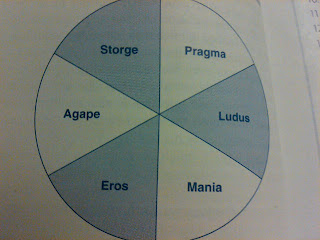This chapter goes off on explaining the levels of love and their exceptions in every occurrence. It explains the difference between loving and liking, and talks about love in three major perspectives.
1) Lee's Love styles 2) Sternberg's triangular theory of love 3) Marston and Hecht's love ways.
Types of Love
Companionate Love- Hatfield (1988) referred to this type of love as the "warm" type of love. Its level of intimacy is always consistent. Examples of Companionate Love are family relationships, friendships, and romantic relationships.
Passionate Love- Hatfield (1988) referred to this type of love as the "hot" type of love. This level of love is characterized by emotional highs and lows rather than a consistent and personal warmth. When we are in passionate love, we feel amazing and in a state of satisfaction when things go our way. When we are rejected, we are in misery.
Lee's Love Styles
I thought this theory was interesting, especially because of the strange names given to the pieces of pie.
Eros- physical love
Storge- companionate love
and Ludus- game-playing love... are all Primary Styles of Love
According to Lee, if you mix these primary styles (just like primary colors), you are able to make different or "secondary" styles (or colors).
Mania- possessive love
Agape- unselfish love
and Pragma- practical love.. are the three most common Secondary Styles of Love
Attachment
According to the book, attachment is conceptualized through love connections. This attachment usually tends to get stronger as relationships progress.
An attachment style is a social interaction style that is consistent with the type and quality of relationship one wishes to share with others, based on working models of self and others (Bartholomew, 1990).
They also say in the book that attachment styles in childhood are models shaped for attachment in later years in life. A classic example would be a baby crying for her mother as an infant.
Attachment in adulthood are conceptualized by previous attachments with others. Hazan and Shaver (1987) proposed that adults can have secure, avoidant, or anxious-ambivalent attachments to their romantic partners.
Secures- These people tend to get close to their partners in a sense of dependence. They often fear being left.
Avoidants- These people are uncomfortable with getting close with their partners. They really do value their "autonomy". (Sounds like me)
Anxious Ambivalents- These people are overly involved and can be demanding towards their partner.
An attachment style is a social interaction style that is consistent with the type and quality of relationship one wishes to share with others, based on working models of self and others (Bartholomew, 1990).
They also say in the book that attachment styles in childhood are models shaped for attachment in later years in life. A classic example would be a baby crying for her mother as an infant.
Attachment in adulthood are conceptualized by previous attachments with others. Hazan and Shaver (1987) proposed that adults can have secure, avoidant, or anxious-ambivalent attachments to their romantic partners.
Secures- These people tend to get close to their partners in a sense of dependence. They often fear being left.
Avoidants- These people are uncomfortable with getting close with their partners. They really do value their "autonomy". (Sounds like me)
Anxious Ambivalents- These people are overly involved and can be demanding towards their partner.









